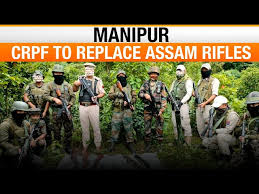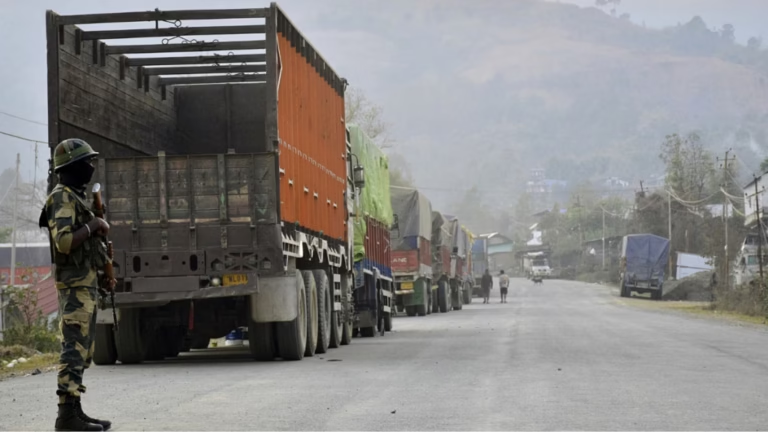CRPF Replaces Assam Rifles in Kangpokpi, Manipur: A Major Shift in Security
Summary
In a significant move, the Central Reserve Police Force (CRPF) has taken over from Assam Rifles in Manipur’s Kangpokpi district. This change comes amid the state’s ongoing ethnic tensions, with the CRPF assuming greater responsibility for maintaining law and order. The deployment shift is seen as an effort to calm tensions and create a neutral force in areas where ethnic strife has been ongoing.
The Strategic Shift: CRPF Replaces Assam Rifles in Kangpokpi, Manipur
Introduction
The northeastern state of Manipur has been under the spotlight for months, grappling with civil unrest and ethnic tensions. As a region known for its complex socio-political landscape, maintaining peace is often a delicate and challenging task. One of the latest developments in this ongoing situation is the strategic decision to replace the Assam Rifles with the Central Reserve Police Force (CRPF) in the sensitive district of Kangpokpi.
This decision, coming at a critical juncture, has raised both eyebrows and hopes for a more balanced approach to security in the area. So, why the shift? What does this mean for Manipur’s future, especially for Kangpokpi’s residents who are at the center of the ethnic strife? Let’s dig deeper into the reasons, implications, and broader context of this important security change.
Understanding the Context: Ethnic Tensions in Manipur
A Brief History of the Conflict
Manipur, like several other northeastern states, is a melting pot of ethnicities, cultures, and languages. While this diversity is a hallmark of the region, it has also been the source of deep-rooted conflicts, particularly between the Meitei and Kuki communities. The strife between these groups is not a recent development but has been exacerbated by socio-political factors such as land rights, autonomy, and political representation.
Over the past several months, violence between these ethnic groups has spiked, leading to numerous casualties, displacement, and destruction of property. The delicate situation in Kangpokpi—a district with a mixed population—required a sensitive and neutral force to restore order.
Why CRPF Replaced Assam Rifles: The Key Reasons
1. Neutrality in the Conflict
One of the key reasons behind replacing Assam Rifles with CRPF is the perceived neutrality of the latter. Assam Rifles, an older paramilitary force, is sometimes seen as having historical and regional affiliations that may influence their operations. In contrast, the CRPF is viewed as a neutral national force, one that can be trusted by all parties involved in the conflict.
This shift is aimed at diffusing tensions by instating a force that doesn’t carry the baggage of historical ties or allegiances within the state. For a region where even small actions can escalate conflict, neutrality is paramount.
2. The Need for Specialization in Internal Security
The CRPF has a proven track record when it comes to handling internal security, civil unrest, and law and order situations across the country. While Assam Rifles is largely known for its operations in insurgency-hit regions and guarding the India-Myanmar border, the CRPF is more adept at dealing with situations like the one in Kangpokpi—where civil unrest and ethnic violence require specialized crowd-control measures and conflict de-escalation techniques.
3. Building Trust Among Communities
For any force to be effective in conflict resolution, it needs the trust of the people. In the case of Assam Rifles, there were growing concerns from certain factions within the community that the force had a bias or an agenda in favor of specific ethnic groups. By bringing in CRPF, the government aims to rebuild that trust, sending a message that a neutral and professional force will now be responsible for maintaining peace and order.
Implications of the CRPF Deployment
1. Immediate Calm or Temporary Relief?
The hope with this redeployment is that the immediate tensions will be eased. CRPF’s reputation and capabilities in handling riot-like situations should lead to a more controlled environment in the short term. However, it’s worth asking—will this be a temporary band-aid on a much deeper issue, or can it help lay the groundwork for long-term peace?
The underlying ethnic tensions are deeply rooted in issues of identity, land, and political representation. While CRPF can maintain peace on the ground, long-term solutions will have to address these fundamental issues through dialogue, political negotiation, and social reforms.
2. Enhancing Law and Order
CRPF is not just being deployed for crowd control or conflict management; they are here to enhance overall law and order in Kangpokpi. Their deployment is expected to lead to better policing, more accountability, and a crackdown on illegal activities that may be fueling the conflict. This enhanced security could lead to more people feeling safe to return to their homes, rebuild their lives, and engage in the reconciliation process.
3. Potential for Military-Civilian Relations
One of the positive outcomes of having CRPF replace Assam Rifles could be an improvement in military-civilian relations. The CRPF, being a civilian-policing force under the Ministry of Home Affairs, may bring a softer, more community-centric approach to security, as opposed to the more militarized presence that Assam Rifles is known for. This might lead to better interaction and collaboration between the security forces and local communities.
Challenges Ahead for CRPF
1. Navigating Local Complexities
While the CRPF brings neutrality and experience to the table, they will still face the challenge of navigating the local complexities of Manipur’s conflict. They will need to understand the cultural and historical nuances of the region to effectively mediate between warring factions and manage law and order.
2. Long-Term Peace vs. Short-Term Stability
The CRPF’s mandate may help establish immediate stability, but the road to long-term peace in Manipur is far from over. Peace-building measures, dialogues between ethnic groups, and political negotiations will need to follow this deployment. Without addressing the root causes of the conflict, this peace might be temporary.
3. Risk of Escalation
In volatile regions like Kangpokpi, even minor missteps by security forces can escalate tensions. The CRPF will have to be extremely cautious in how they handle situations, especially when dealing with sensitive community issues. Their success will largely depend on how they can balance force with diplomacy.
The Role of the Government in Conflict Resolution
Supporting the CRPF with Adequate Resources
The deployment of the CRPF is just one part of the solution. The state and central government must provide the force with adequate resources, intelligence, and support to carry out their duties effectively. A well-coordinated effort between the local administration, security forces, and the central government is crucial for lasting peace.
Fostering Dialogue and Reconciliation
Security measures alone cannot resolve the conflict in Kangpokpi. The government needs to foster dialogue between the warring ethnic groups, ensuring that grievances are addressed through peaceful means. The involvement of community leaders, civil society, and independent mediators can play a crucial role in building bridges between divided communities.
Ensuring Justice and Accountability
Justice for the victims of violence is essential for any lasting peace in Manipur. Ensuring that perpetrators are held accountable, regardless of their ethnic background, will be crucial in rebuilding trust among the affected communities.
Conclusion: A Step Toward Peace?
The replacement of Assam Rifles with CRPF in Kangpokpi, Manipur, represents a crucial step in managing the ethnic tensions that have plagued the region for months. While this move signals a more neutral and professional approach to handling the crisis, it’s important to remember that security forces can only provide immediate stability. Long-term peace will require sustained efforts from the government, civil society, and the communities themselves. It’s a tough road ahead, but this could be the first step toward lasting peace in Manipur.
FAQs
- Why was Assam Rifles replaced by CRPF in Kangpokpi?
Assam Rifles was replaced to ensure a neutral, unbiased force manages the ethnic tensions and law-and-order situation in Kangpokpi. - What are the key challenges for CRPF in Manipur?
CRPF will face challenges in navigating local complexities, balancing short-term stability with long-term peace, and avoiding escalation in sensitive areas. - How will the CRPF deployment impact local communities?
The CRPF is expected to enhance law and order, potentially easing tensions and rebuilding trust between local communities and security forces. - What role does the government play in conflict resolution?
The government needs to support the CRPF with resources, foster dialogue between ethnic groups, and ensure justice for victims of violence. - Can CRPF solve the conflict in Manipur?
While CRPF can provide immediate stability, long-term peace will require addressing the underlying causes of ethnic tensions through dialogue and political solutions.




